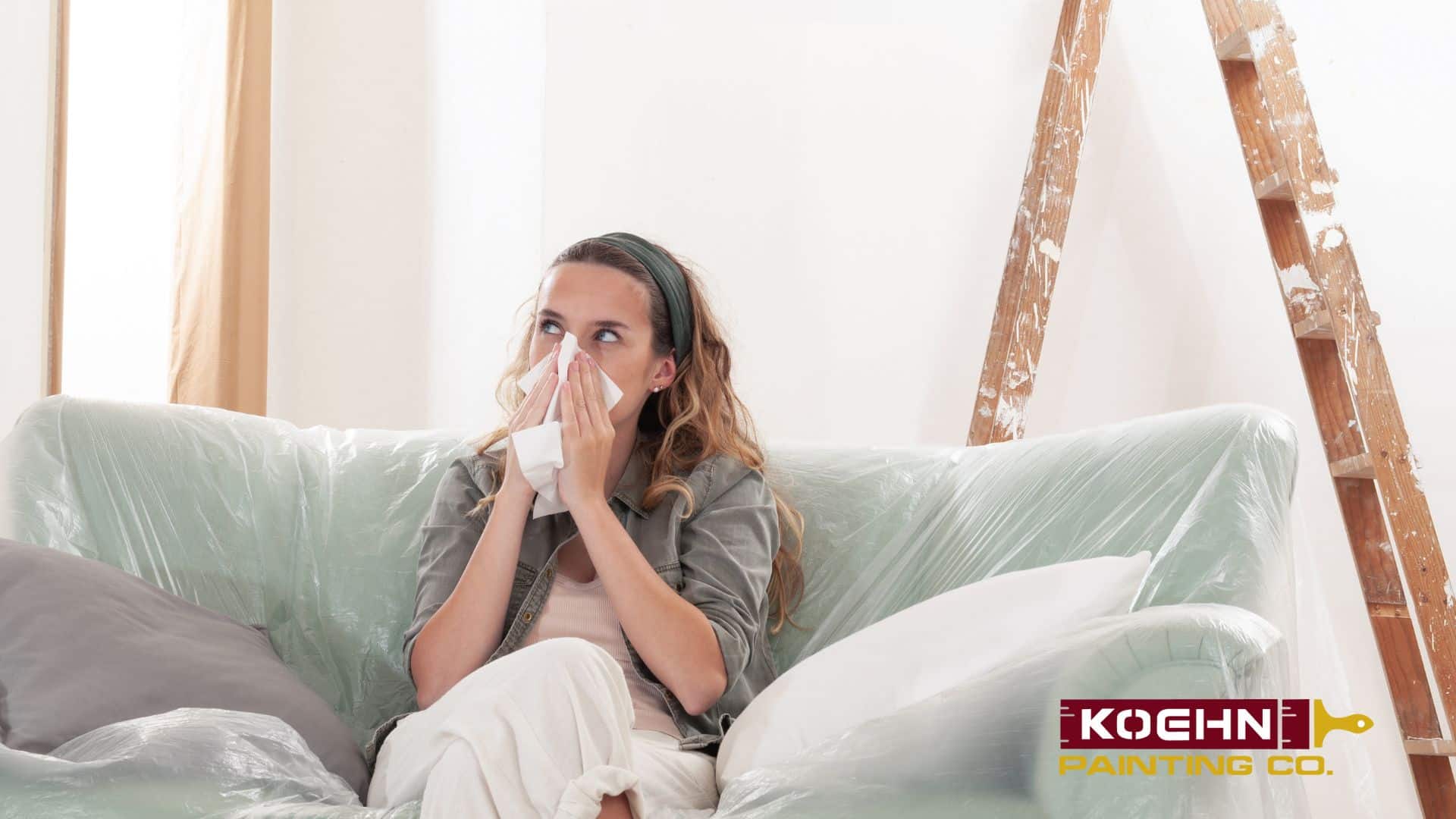Table of Contents
ToggleIt’s common for many people to walk into a freshly painted room and immediately feel their noses twitch, their eyes water, or even a tightness in their chests. These could be signs of paint allergy, which an increasing number of people are discovering they might have, along with other reactions to paint fumes.
According to the World Health Organization, indoor air pollution caused by volatile organic compounds (VOCs) found in paint can trigger allergies, asthma, and respiratory discomfort in millions worldwide. The reason is that VOCs are airborne chemicals that linger long after the paint dries.
These compounds, often found in traditional paints, can cause anything from sneezing and coughing fits to itchy, watery eyes and, in some cases, trigger asthma attacks in individuals with pre-existing conditions.
Studies show that VOC concentrations can be up to ten times higher indoors than outdoors after a fresh paint job. That’s a staggering statistic, especially for those with pre-existing conditions like asthma or allergies.
But here’s the good news: choosing the right painting contractor can make all the difference. With the right expertise and hypoallergenic paint options, a painting project doesn’t have to come at the cost of health. So, how can you protect yourself and your family while still achieving the perfect finish? Let’s dive in.
Can You Be Allergic to Paint? Understanding Paint Allergy

Can you be allergic to paint? The short answer is yes. Paint is a part of everyday life, coating the walls of homes, offices, shopping malls, and just about every building we enter. However, while paint may seem harmless, it can cause considerable allergic reactions in some people, especially those sensitive to chemical fumes or direct skin contact.
Paint allergy occurs when strong vapors or allergens in paint trigger the body’s immune response, with VOCs being the main culprit in most oil-based and even some water-based paints. These airborne irritants can linger for days or weeks after a fresh coat, affecting those who inhale the fumes or touch the wet paint.
But then, how do you know if you’re allergic to paint? Symptoms of paint allergies vary depending on whether the reaction is caused by inhalation of fumes or direct skin contact— which is the most frequent way of catching an allergy.
Here’s a deeper look into each category, along with the symptoms and why they occur:
- Inhalation of paint fumes
When one inhales paint fumes, the chemicals (especially VOCs) irritate the respiratory tract and can affect other body parts. Common symptoms include:
- Runny nose: Caused by the mucous membranes in the nose reacting to chemical irritants. This is the body’s natural way of trying to flush out the irritants.
- Sore throat: VOCs can irritate the lining of the throat, leading to inflammation and discomfort.
- Nasal congestion: Inflammation in nasal passages can cause swelling, making it harder to breathe through the nose.
- Coughing: A reflex triggered by the body to expel the inhaled irritants from the airway.
- Irritated, watery eyes: Fumes can irritate the sensitive mucous membranes of the eyes, leading to redness and excessive tearing.
- Wheezing or shortness of breath (for asthma sufferers): VOCs can trigger bronchial spasms, causing the airway to narrow, which leads to difficulty breathing.
- Direct skin contact with paint
When paint comes into direct contact with the skin, the allergens or irritants in the formula can penetrate or irritate the outer layers of the skin. Common symptoms include:
- Localized rashes: Chemicals like Methyl Methacrylate (MMA) disrupt the skin’s natural barrier, leading to red, inflamed areas.
- Redness: A common sign of irritation caused by the body sending extra blood to the affected area to combat the allergen.
- Itchiness: A reaction to the release of histamines, a chemical the body produces in response to allergens.
- Swelling: Caused by fluid accumulation in the affected area due to inflammation.
- Blistering: Severe reactions can cause the skin to form blisters as a defense mechanism, creating a barrier to isolate the irritant.
Identifying whether the symptoms stem from inhalation or skin contact can help one take targeted steps to reduce exposure and manage the reactions.
The Increasing Prevalence of Paint Allergies
In recent years, concerns over paint allergies have grown, reflecting the broader issue of indoor air pollution and its effects on health. With people spending up to 90% of their time indoors, according to the Environmental Protection Agency (EPA), exposure to indoor pollutants such as VOCs has become a pressing issue.
VOCs, commonly emitted by household paints, are significant contributors to indoor air pollution and can harm vulnerable populations like children. Studies suggest a notable correlation between high concentrations of VOCs from freshly painted walls and respiratory diseases in children, including asthma and allergic rhinitis.
While low-VOC paints are increasingly available, evidence shows that even minimal exposure to VOCs can stimulate respiratory irritation and allergic reactions, especially in children with pre-existing conditions. These findings emphasize the urgent need for stricter regulations, awareness campaigns, and the adoption of hypoallergenic paints to mitigate the growing prevalence of paint-related allergies.
Paint Ingredients to Avoid Beyond VOCs
Beyond VOCs, several other harmful ingredients in paints can trigger allergic reactions, respiratory irritation, and even long-term health issues. Here are the key culprits to watch out for:
- Formaldehyde: Commonly used in some paint resins, formaldehyde is a well-known allergen and irritant. It can cause watery eyes, coughing, and skin irritation. Prolonged exposure has been linked to respiratory problems and an increased risk of certain cancers.
- Benzene and toluene: These aromatic hydrocarbons, found in some solvent-based paints, contribute to indoor air pollution. Benzene is a carcinogen, while toluene can affect the nervous system, causing dizziness, headaches, and respiratory irritation.
- Ammonia: Frequently added to improve paint consistency, ammonia releases strong fumes that can irritate the respiratory system. This can lead to coughing, throat irritation, and difficulty breathing, especially in individuals with asthma or allergies.
- Heavy metals (lead and mercury): Though less common in modern paints, lead and mercury are extremely hazardous. Exposure to lead, particularly in older paints, can cause developmental issues in children, while mercury is toxic to the nervous system and kidneys.
Avoiding these ingredients and opting for low-toxicity, hypoallergenic paints can significantly reduce health risks, especially in homes with children or individuals with respiratory conditions.
Contact us here if you would like to find the best painting contractor for your residential or commercial painting needs.
Avoid Allergic Reaction to Paint By Choosing the Right Materials

Avoiding an allergic reaction to paint requires careful consideration of the materials brought into a living or working space. Unfortunately, many paints contain VOCs and other irritants that can negatively impact one’s health, particularly for individuals sensitive to allergens.
If one suspects they might have a paint allergy or simply wants to avoid the possibility, choosing hypoallergenic or low-VOC paints can make a difference. These alternatives are specifically formulated to minimize exposure to harmful chemicals, reducing the likelihood of adverse reactions.
So, can you be allergic to paint? Yes, but you can also do something about it. Here’s a guide to understanding the allergenic potential of different paints and selecting materials that prioritize health and safety.
Types of Paints and Their Allergenic Potential
- Oil-based paints: Oil-based paints have a high allergenic potential. These paints are high in VOCs and solvents like benzene and toluene, which emit harmful fumes that can linger for weeks, causing respiratory irritation, headaches, and oil paint allergy symptoms such as wheezing and nasal congestion.
- Latex (water-based) paints: These paints have a moderate to low allergenic potential. However, while lower in VOCs compared to oil-based paints, they may still contain preservatives like ammonia, which can cause skin irritation and respiratory issues in sensitive individuals.
- Acrylic paints: Acrylic paints have a moderate allergenic potential. These paints often include VOCs and chemical additives, which can lead to acrylic paint allergy symptoms like itchy skin, rashes, and eye irritation.
- Enamel paints: Enamel paints have a high allergenic potential. Known for their durability, these solvent-based paints have strong fumes and high VOC levels, which can exacerbate asthma or trigger paint allergy symptoms in sensitive individuals.
- Chalk paints: Chalk paints have a low allergenic potential. Generally free of harmful chemicals and VOCs, chalk paints are a safer choice, but verifying the brand’s safety claims is essential.
- Milk paints: These paints have a very low allergenic potential. Because they are made from natural ingredients like casein and lime, these paints are VOC-free and hypoallergenic, though individuals with milk allergies should proceed with caution.
- Clay and mineral-based paints: These have very low allergenic potential, as well. Composed of natural materials, these paints are chemical-free, making them an excellent choice for people with chemical sensitivities or those looking to avoid an allergic reaction to paint.
Choosing the right paint is crucial for minimizing health risks, especially for those prone to allergies. Painting specifically labeled as hypoallergenic or VOC-free is the best option to prevent an allergic reaction to paint.
Milk paints and clay-based paints are excellent options, providing beautiful finishes with minimal risk of reactions. And for those needing durability and versatility, VOC-free acrylic paints are also a safe alternative that minimizes acrylic paint allergy symptoms.
Also, proper ventilation during and after painting can further reduce the risk of irritant exposure, especially in enclosed spaces. With the growing availability of eco-friendly, low-toxicity options, it’s easier than ever to achieve a stunning, allergen-free finish while protecting one’s health and the environment.
Benefits of Using VOC-Free and Hypoallergenic Paints
We’ve said that opting for VOC-free and hypoallergenic paints is the best solution to avoid paint allergy symptoms. Here’s why:
- Low or no odor: VOC-free paints emit little to no smell, making them ideal for individuals sensitive to strong fumes.
- Non-toxic: Free from harmful chemicals, these paints pose no health risks for children, pets, or sensitive individuals.
- Improved indoor air quality: These paints create a healthier and safer indoor environment by eliminating VOCs.
- Hypoallergenic: Specially designed to reduce allergens, they are less likely to trigger respiratory or skin reactions.
- Eco-friendly: Made from natural materials such as clay, minerals, and plant oils, these paints are sustainable and better for the environment.
Steps to Minimize Paint Allergies During Painting Projects
Taking the right precautions during painting projects can help reduce the risk of a paint allergy or other health-related issues caused by harmful chemicals. Follow these steps to ensure a safer and healthier painting experience.
Choose safer paint options
- As mentioned above, look for paints with low or no VOC; that’s paints with less than 50 grams of VOCs per liter for flat finishes and under 100 grams per liter for non-flat finishes. When tinting the paint, you can also select low- or no-VOC color additives to maintain air quality.
- We’ve also mentioned milk paints, but those are not the only hypoallergenic options. They are VOC-free and made with natural ingredients. Try mineral- or plant-based pigments as they are less toxic and present fewer health risks than conventional pigments.
- Stay away from paints labeled as “antifungal” or “antimicrobial.” These products often contain pesticide additives that can pose health risks, especially for people with respiratory sensitivities or skin allergies.
Correctly set up your space
- Work in a well-ventilated area. No matter the type of paint, ensure proper ventilation by opening windows and using fans to keep the air circulating. This step is crucial even when using low-VOC paints, as it helps minimize exposure to any lingering fumes.
Use the right equipment
- Use protection. Always wear a respirator when sanding or preparing surfaces to avoid inhaling fine dust particles, which can trigger allergies or respiratory irritation. Additionally, gloves and long sleeves can help reduce skin contact with paint and solvents.
- Avoid traditional paint strippers. When removing old paint, choose alcohol- or soy-based strippers instead of conventional ones containing methylene chloride. These safer alternatives minimize exposure to toxic fumes and carcinogens, offering better protection during your project.
- Plan your coats wisely. Assess the performance and durability of the paint to reduce the number of coats needed. Even with low-VOC paints, using fewer coats can help minimize overall VOC emissions and their impact on indoor air quality.
If the person in charge of the project carefully follows these steps, the risk of paint allergy problems will diminish significantly, allowing a healthier, safer environment throughout the process.
Avoid Paint Allergy and Other Health Issues by Hiring a Painting Contractor

Hiring a professional painting contractor can be a game-changer for those prone to paint allergy or other health issues triggered by paint fumes. Professionals not only ensure a flawless finish but also reduce the health risks associated with painting projects, thanks to their expertise and use of safer materials.
Paint allergies are more common than you might think, especially for individuals sensitive to VOCs or other harmful chemicals present in paints—and many people don’t even know they fall into this category.
24 million people in the U.S. alone suffer from environmental allergies, many of which include sensitivity to paint. The fumes emitted during and after painting, especially from high-VOC or chemical-laden paints, can linger for years, causing health problems such as respiratory issues, skin irritation, and even long-term neurological effects.
While DIY painting might seem appealing, it often involves handling these harmful chemicals without the necessary precautions. Improper techniques or using conventional paints can exacerbate allergy symptoms, making the experience unpleasant and potentially hazardous. Professionals, however, are equipped to mitigate these risks. Here’s how:
- Expert knowledge of safer paints: Professional painters are well-versed in selecting low-VOC, zero-VOC, or hypoallergenic paints. These options emit fewer harmful fumes and are often free of chemicals like formaldehyde or preservatives that can trigger allergic reactions. They can also guide you toward specialized products such as mold-resistant or washable paints to further improve the health and cleanliness of your indoor environment.
- Proper ventilation techniques: We’ve said that ventilation is critical in reducing exposure to paint fumes during and after the project. Professionals ensure proper airflow using advanced ventilation methods, such as creating cross-breezes or deploying air filtration systems. This reduces the concentration of VOCs in the air, making the space safer for occupants—especially those with respiratory sensitivities.
- Advanced equipment and precautions: Professional contractors use industry-grade tools and protective equipment to handle paints safely. For example, they wear respirators and gloves, minimizing their exposure to harmful chemicals. By doing so, they can execute the project without compromising their health or yours.
- Allergy-friendly application techniques: The method of application matters. Professionals know how to evenly apply paint, which helps reduce the risk of cracking or peeling—conditions that can harbor allergens like dust or mold over time. They also ensure the paint cures properly, which minimizes the release of VOCs into your home.
- Customization for allergy needs: A key advantage of hiring a professional is their ability to customize the project based on your specific allergy concerns. They can recommend hypoallergenic options, address pre-existing indoor air quality issues, and adjust their approach to meet your unique requirements. For instance, if you’re prone to oil paint allergy symptoms or acrylic paint allergy symptoms, they can guide you toward safer alternatives.
Long-term health benefits
The long-term health benefits of professional painting extend beyond the immediate reduction of fumes. Using low-VOC paints and maintaining proper ventilation during the process can help:
- Improve indoor air quality.
- Reduce respiratory issues such as chronic coughing or asthma flare-ups.
- Lower the risk of skin irritation and other allergic reactions.
- Minimize the accumulation of allergens like mold, dust mites, and other irritants.
By investing in professional services, you’re not just hiring painters—you’re ensuring a healthier living environment for you and your family.
Conclusion
A freshly painted home doesn’t have to come at the cost of your health. While DIY projects may seem cost-effective, they often lack the necessary precautions to prevent a paint allergy or exposure to harmful chemicals. Professional painting contractors bring expertise, high-quality materials, and advanced techniques to the table, creating a safe and allergy-friendly space.
Whether you’re looking for a mold-resistant finish or a hypoallergenic alternative, partnering with professional solutions like Koehn ensures that every detail is handled with care, discussing your needs, prioritizing your health, and transforming your home into a sanctuary free of allergens and health risks.
Discover the Koehn Painting difference – contact us today for a free estimate and step into a vibrant, freshly painted home!





